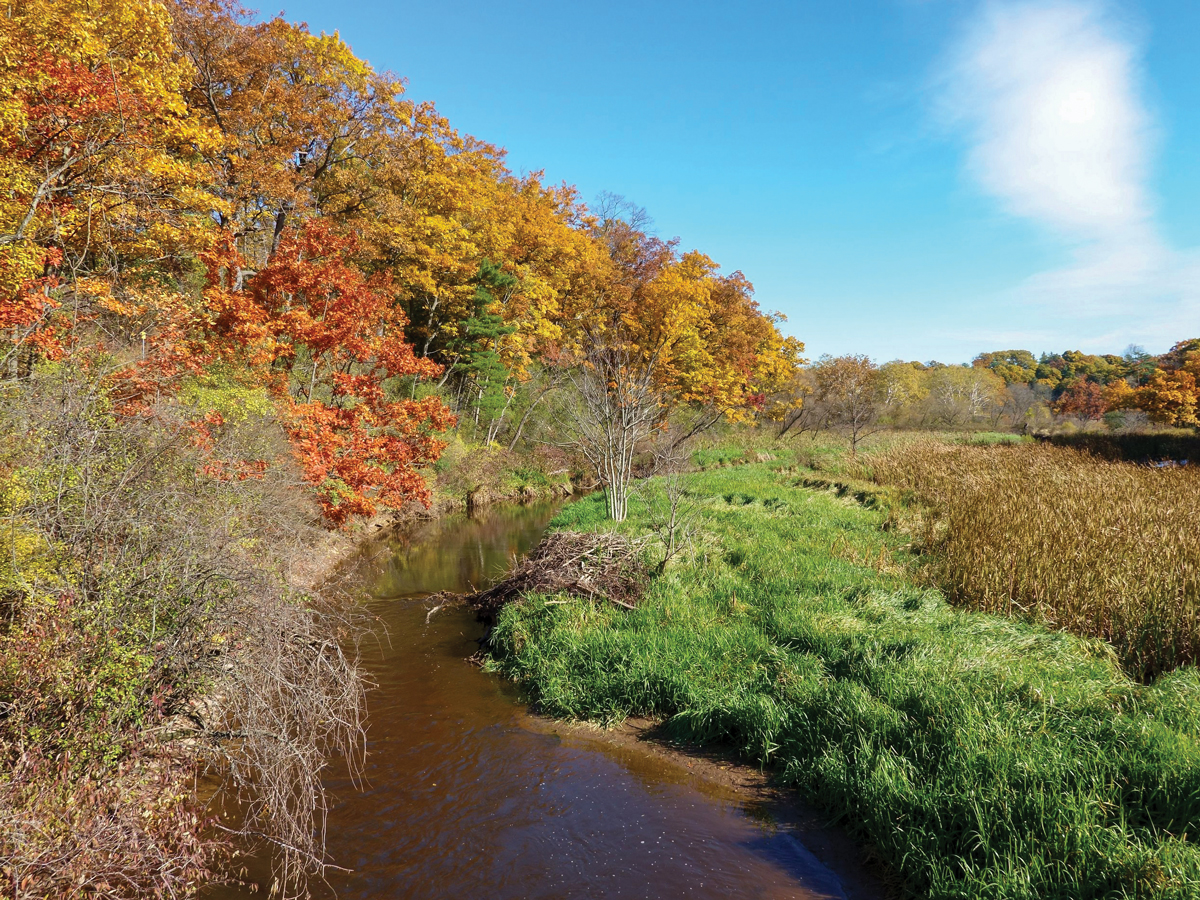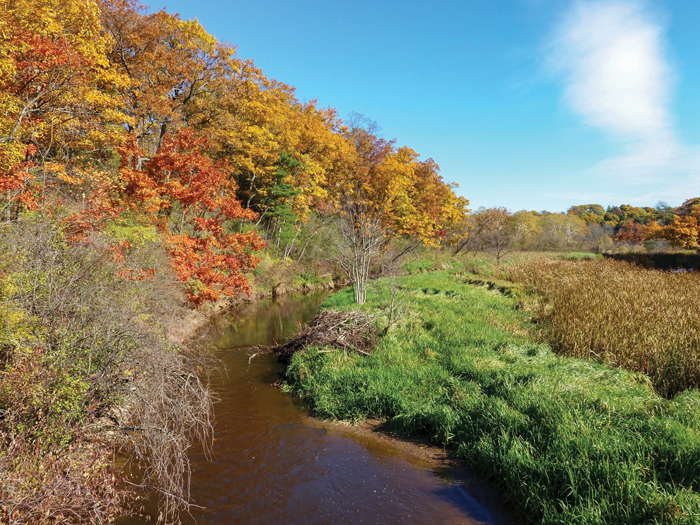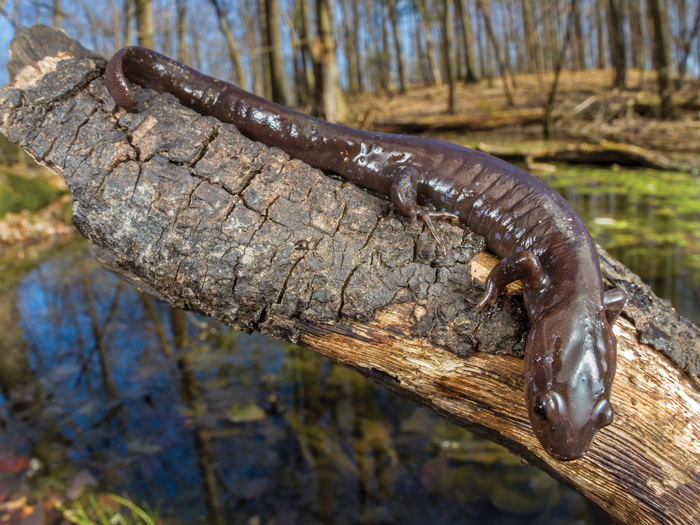
Could natural asset accounting become the wave of the future?
 The forests and swamps of the Grindstone Creek area, near Hamilton, Ont., act as filters for stormwater as it travels to Lake Ontario (Alami)
The forests and swamps of the Grindstone Creek area, near Hamilton, Ont., act as filters for stormwater as it travels to Lake Ontario (Alami)
As you walk along the banks of the Grindstone Creek, which meanders through the Ontario cities of Burlington and Hamilton, it almost feels like you’re in another world.
Bracketed by towering maples, the watercourse rushes over waterfalls, plunges into atmospheric valleys and splays out over duck-filled wetlands.
Despite scything through farms and subdivisions, the creek and its surrounding watershed is bursting with wildlife, including species at risk like the red mulberry tree, the monarch butterfly and the red-headed woodpecker. Its star attraction, however, is probably the Jefferson salamander, a candy-bar-sized amphibian so rare, Burlington closes a major road each spring so they aren’t squashed en route to their mating grounds.
“There are parts of this watershed that are just gorgeous,” says Kim Barrett, Associate Director, Science and Partnerships at Conservation Halton, the public agency that manages the area. “When you’re in one of these deep valleys, it doesn’t feel like you’re in southern Ontario. It feels like you’re somewhere much wilder.”
As scenic as it is, Grindstone Creek is more than just a place to escape the urban jungle. Its forests, swamps and valleys act like a giant sponge, sopping up stormwaters before channeling them into Lake Ontario. Ecologists like Barrett have long known that was a valuable service. But now they know exactly how valuable.
A study released in August 2022 found that if the Grindstone watershed collapsed, Hamilton and Burlington would need to spend $2 billion on stormwater infrastructure to protect local homes and farms from flooding.
For many environmentalists, studies like that have long been borderline heretical. “Ecologists have valued nature intrinsically, you know, forever,” says Barrett, whose organization co-funded the Grindstone Creek study. “So, there has been a bit of friction about putting a dollar value on it.”
 The city of Burlington, Ont., closes a major road every spring so the Jefferson salamander can get safely to its mating grounds (Gil Wizen)
The city of Burlington, Ont., closes a major road every spring so the Jefferson salamander can get safely to its mating grounds (Gil Wizen)
But as natural spaces disappear, many are coming around to the idea. And they’re finding allies in an unlikely place: the world of public sector accounting.
In recent years, a growing number of municipalities have attempted to place a dollar value on the often-invisible services that nature provides. The worry is that as urban development and climate change chisel away at natural landscapes across Canada, those places are losing their ability to filter water, hold soil, and draw pollution from the air.
If these ecosystems collapse, they could leave Canadian municipalities facing multi-billion-dollar bills for new infrastructure. Yet those risks are not reflected on public financial statements.
Bailey Church, leader of KPMG’s National Public Sector Accounting Advisory service line, called the issue a fiscal “time bomb” for municipalities.
“If you go back to what public-sector financial statements are meant to do, they’re designed to track the resources available to provide services,” said Church. If municipalities just focus on traditional capital assets—like land, buildings and equipment—they’re “missing the biggest piece of the puzzle,” he believes.
“We’re just beginning to open our eyes to the full extent of these benefits.”
Nearly every settlement on Earth relies on the natural world to function. Rivers serve up drinking water. Honeybees pollinate crops. Wetlands shield communities from storm surges. Rivers channel stormwaters away from homes. And forests scrub the air of planet-warming greenhouse gases.
The World Economic Forum estimates that over half of the global gross domestic product—valued at some $44 trillion—is moderately or highly dependent on nature and its services.
But the natural buffet isn’t bottomless, and humans are voracious dinner guests.
We have “significantly altered” three-quarters of the Earth’s dry land, according to the United Nations, with our farms and cities pushing ever deeper into previously untouched spaces.
As the global population surges—it’s expected to hit nearly 10 billion by 2050—and climate change unleashes a mix of floods, droughts, and rising seas, natural spaces will continue to dwindle. Experts say that if they do, cities could be in serious trouble.
Roy Brooke, the executive director of the Municipal Natural Assets Initiative (MNAI) sees this as a global challenge.
The non-profit group helps civic leaders (among others) across Canada value, understand, account for, protect and manage their natural capital. Brooke estimates that about 100 Canadian municipalities, from Toronto to tiny Rossland, B.C. have at least dabbled in the field.
“On the one hand that is good,” Brooke says. “On the other hand, it is kind of crappy when you consider that there are almost 4,000 local governments in Canada.”
Municipalities own about 60 per cent of Canada’s infrastructure and make most of the decisions on land use. Those that don’t attempt to value nature when planning for the future are rolling the dice with their finances, Brooke says. “Every hour of every day, year in year out, local governments, and many others, are making decisions about zoning, land use and investment with at best an incomplete understanding of the impacts of those decisions.”
Last year, University of Waterloo’s Intact Centre on Climate Adaptation, MNAI and KPMG Canada backed study on natural capital. Titled Getting Nature on the Balance Sheet, it examined what it would cost cities to replace damaged or threatened natural assets with built infrastructure.
Some of the totals were hefty. Gibsons, B.C., for example, would need to spend between $3.5 and 4 million on stormwater storage if it lost a series of naturally occurring ponds. It would cost Oshawa, Ont., nearly $19 million worth of drainage work to replace one local creek. And in Quebec City, civic officials would need to shell out about $50 million annually to mimic the flood control capabilities of nearby wetlands.
Church says the embrace of the principles behind them is an important step forward for the accounting world.
“If we had this conversation 10 years ago, even five years ago, this would've been viewed as a very very nice concept, but something that's not necessarily real,” says Church. “Now I think we’re realizing ‘No, no, no,’ these are critical, essential benefits we’re seeing.”
As cities push forward with valuing their natural assets, one major question looms over the accounting world: what’s to be done with these numbers?
Right now, municipalities follow a hodgepodge of standards for valuing assets, some borrowing from guidelines developed by the United Nations. (The UN’s framework is known as the System of Environmental-Economic Accounting.) At the same time, there are no rules governing where valuations should go. Should they be add-ons to sustainability reports, documents that chart a government’s overall impact on the environment? Or should they be embedded in financial statements, a move that would require municipalities to be much more rigorous in how they track and manage their natural assets?
The answers to those questions could be coming soon.
In May 2022, the International Public Sector Accounting Standards Board, which develops global accounting guidelines, released a consultation paper on natural resources reporting. The paper was the first step in what is likely a years-long process of standard setting. But it outlined the organization’s thinking on the future of natural capital accounting. In short: it likes the idea.
The board said that if certain conditions are met, natural assets should be recognized…in general purpose financial statements.
The paper looked at how commodities, like freshwater and oil, might be accounted for. But it also suggested that natural resources don’t need to take a physical form in order to be considered an asset. That would seemingly open the door to including natural services, like a wetland’s ability to filter pollutants from drinking water, on balance sheets. Provisions like that are considered key to protecting the entirety of landscapes, especially ones that can’t be commoditized.
The international board recommended that to be considered an asset, a natural resource must be controlled by a public body. (That standard could mean, for example, that water in a small lake would be considered an asset but water in a transboundary river wouldn’t be.) The paper added that control must be the result of a past event, like a land purchase or treaty.
The board also said governments must be able to reliably measure the value of that asset using accounting principles like relevance, timeliness and verifiability.
Canada’s Public Sector Accounting Board (PSAB), which sets this country’s accounting standards for the public sectors, drawing on international guidelines, has welcomed the push toward standardization. It submitted comments last year on the consultation paper after meeting with municipal and Indigenous governments across the country.
The board’s director of public sector accounting, Michael Puskaric, said the attempt to value natural assets is an important “evolution” in accounting given the pressure on the planet.
“There are certainly challenges when it comes to auditing, tracking and recognizing natural resources. Those need to be worked through,” said Puskaric. “But I think it comes down to the concept of what gets measured gets managed.”
At least initially, he thinks reporting on natural resources will have to reside outside of financial statements but as measurement techniques evolve, that may change.
Long-term, listing at least some natural assets in financial statements is crucial, says KPMG’s Church. It would compel municipalities to consider the financial costs of replacing those resources. And it would force cities to write down compromised natural spaces, like a wetland that’s so polluted it can’t filter water.
“If we have equity investments and the market goes down, what do we do? We rate those down, we take a loss. We don't do that with the wetland,” says Church. “Having (natural assets on) financial statements is key to me from a transparency perspective and accountability perspective.”
As the regulatory process unfolds, many are pushing forward with natural capital accounting. The MNAI, KPMG Canada, and the University of Waterloo’s Intact Centre are developing voluntary non-binding standards for municipalities that want to dip their toes into the field, until PSAB rules change. (Some PSAB staff and board members are sitting observers during the process.) An outline has been developed of the guidance and the coalition is now determining how to actually build it out and create the guidance.
“By definition, a PSAB process takes between three to six years,” says Brooke from the MNAI. “There is a requisite amount of transparency and due diligence and consultation that is required—which is just part of the normal process.”
“But we have a whole range of local governments who are saying: ‘Hey, I don't need that stuff in six years’ time. I needed it yesterday.’”
Nova Scotia-born CPA Mike Kennedy became chief financial officer of Rossland, B.C. (pop. 4140), approaching the job with a keen eye and interest on sustainability.
Rossland is set deep in the Kootenay Mountains and when Kennedy arrived in 2021, the city was in the middle of a novel accounting experiment.
Municipal officials had just done an in-depth survey of Rossland’s natural surroundings, including its forests, wetlands and creeks. The report assigned a grade to more than 4,000 natural features and found that many, especially Rossland’s wetlands, were in good condition, which informed the need to track and prolong their health .
It was the first step in an attempt to gauge the value of Rossland’s surroundings and make more informed decisions about urban development and putting nature first in those decisions.
“(Natural asset accounting) isn’t maybe as clear cut as the average CPA would like,” said Kennedy, who taught accounting at Acadia University before decamping to Rossland. “But even if we just take an educated stab at the value nature is providing us, we may make decisions very differently,”
Ultimately, Rossland is hoping to put natural assets at the heart of its planning process.
“We’re trying not to be so reliant on complex, expensive built infrastructure,” said Kennedy. “Nature has a pretty good track record of providing many services, free of charge.”
MORE ON TACKLING CLIMATE CHANGE
Read about Greg Twinney and other accountants who are leveraging their skills to fight climate change and how CPAs can play an important role in ESG initiatives.
Plus, make sure to check out CPA Canada’s extensive sustainability resources on everything from reporting and assurance to professional development and training.